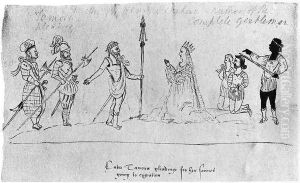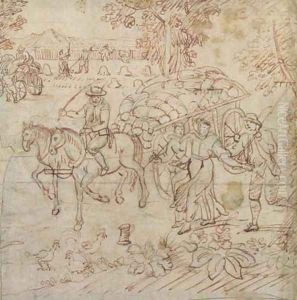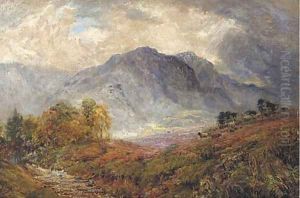Henry Peacham Paintings
Henry Peacham was an English poet, writer, and illustrator, best known for his work 'The Compleat Gentleman', first published in 1622. While Peacham's exact birth and death dates are not definitively known, his life spanned the late Tudor and early Stuart periods, a time of significant change and development in English literature and the visual arts.
Peacham was born around 1546, likely in Hertfordshire, England. He was the son of Henry Peacham the elder, a curate, which allowed him to receive a good education. He attended Trinity College, Cambridge, where he received his bachelor's degree. After his studies, Peacham took on various positions, including schoolmaster and private tutor, which reflected his broad range of interests and competencies in the humanities.
Throughout his life, Peacham was engaged in the cultural milieu of his time, contributing to the arts not only through his writing but also through his skills in drawing and illustration. He traveled extensively in Britain and Europe, which further enriched his knowledge and exposure to the arts.
Peacham's most famous work, 'The Compleat Gentleman', is a conduct book that outlines the qualities and knowledge necessary for a young man of the time to be considered well-rounded and gentlemanly. This includes guidance on education, the appreciation of the arts, and social graces. The book went through multiple editions and was highly influential in the 17th century, shaping ideas about gentlemanly conduct and the value of a classical education.
In addition to 'The Compleat Gentleman', Peacham wrote a variety of other works, including emblem books, which combined images and text to convey moral lessons or complex ideas. His work 'Minerva Britanna' (1612) is one such emblem book, notable for its intricate illustrations and the interplay between visual and literary content.
Peacham's contributions to art history are also significant. He produced one of the earliest known guides to the practice of watercolor painting in England, titled 'The Gentleman's Exercise' (1612). Furthermore, in his writings, he often included observations and critiques of contemporary artists and their works, providing valuable insight into the art world of his time.
Henry Peacham's death is estimated to have occurred around 1634. His legacy is that of a Renaissance man, deeply involved in the intellectual and artistic currents of his day, and his works continue to be of interest for their reflection of early modern English culture and thought.


